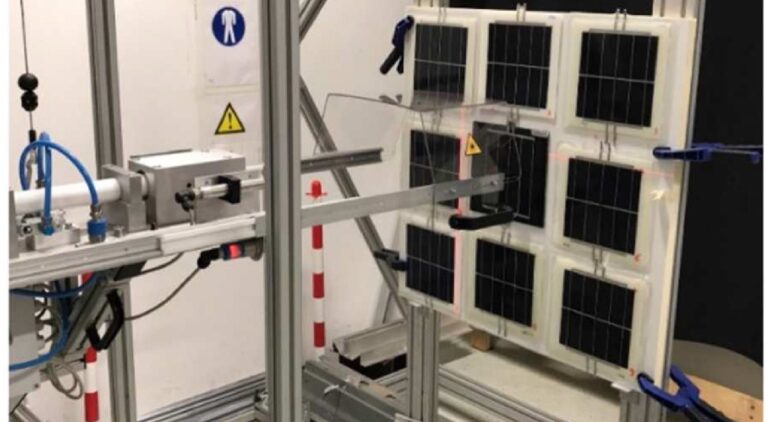Researchers at Germany’s Fraunhofer ISE tested glass fiber reinforced polymer as a front material for vehicle-integrated PV modules, finding that it has the potential to reduce weight by 44% to 74% compared to conventional glass-covered modules. Experimental devices passed hail tests and avoided cell rupture after impact.
Researchers at the Fraunhofer Institute for Solar Energy Systems (Fraunhofer ISE) in Germany have been working on alternative covers for vehicle-integrated PV (VIPV) modules that are lightweight, with competitive optical properties, yet offer resistance to hailstones and other types of mechanical shock. influence.
Previous research highlighted the need for alternative polymer faceplates that perform better than those made from ethylene tetrafluoroethylene (ETFE), according to corresponding author Andre Schüler who was at the Fraunhofer ISE during the research, before joining German PV integrator Next2Sun . .
One of those alternatives is glass fiber reinforced polymer (GRP) based on epoxy composites. After testing as a material for the face of the GFRP, in place of glass, the team found that GFRP reduces weight by 44% to 74% compared to conventional cover glass, depending on the stiffness or thickness of the GFRP layer, while it can withstand various hail impacts. testing.
“The high optical coupling achieved is excellent and was also of great interest when it was first presented at the PVinMotion conference 2024,” Schüler said. pv magazinereferring to a special interest event in Switzerland earlier this year.
The proof-of-concept study showed that GFRP is “definitely an interesting material,” as are polymer-based solutions such as polyethylene terephthalate (PET) or polycarbonate, Schüler said.
The team tested a variety of faceplate combinations, including polymer-based modules made with ETFE with a thickness of 250 μm, two with PET faceplates with a thickness of 275 μm and 300 μm, which were reference modules, and the GFRP faceplate modules with a thickness of approximately 800 μm.
There were six GFRP faceplate variations with two, three and six layers, and a variety of surface fiberglass weights, GFRP weights and GFRP thicknesses. Three module approaches were investigated: a direct fiber lamination approach, a vacuum-infiltrated fiberglass lamination on the faceplate, and a transparent GFRP with industrially produced lamination.
All three variants had a back supported by a 1.5mm GFRP back plate with an added gel coat layer. Larger modules were used to assess stiffness, while smaller mini-modules were used for the hail test and cut sensitivity tests.
Although the modules with GFRP semi-finished products and modules with industrially produced GFRP faceplates showed the most promising optical coupling, the modules produced by direct lamination were not further considered due to insufficient optical coupling, the researchers said.
The pre-infused GFRP faceplate of the PV module stack showed “remarkable optical coupling, maximum power losses of 4% and low susceptibility to failures during the manufacturing process.”
Modules with a GFRP front layer passed thermal cycling tests with low power losses, depending on the individual GFRP layer, according to the team. The cut sensitivity tests reportedly showed better performance compared to modules with a polymer front layer.
“Provided that the GFRP faceplates can be produced cost-efficiently on a large scale, the production concept of GFRP modules remains very close to the standard lamination process of PV modules by simply replacing the polymer-based faceplate film with a GFRP semi-foil. product,” the team said, but also emphasized that further development is needed to optimize the module stack against moisture and UV exposure.
On the potential for technology transfer, Schüler said: “For transfer to industry, IEC requirements would have to be met in all configurations.” It would mean adapting the laboratory process to a GFRP supplier. “So far this is an interesting proof-of-concept, but not an industrial product,” he said.
The work is described in detail in “Towards fiber-reinforced front plates for lightweight PV modules in VIPV”, published in Solar energy materials and solar cells.
This content is copyrighted and may not be reused. If you would like to collaborate with us and reuse some of our content, please contact: editors@pv-magazine.com.


